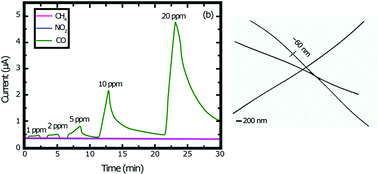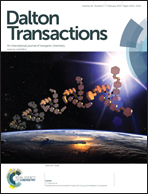Sonochemical synthesis of Au nanowires in the III–I oxidation state bridged by 4,4′-dicyanamidobiphenyl and their application as selective CO gas sensors†
Abstract
In this research, Au nanowires, gold-containing polymers of the formula [(Au(I)-NCN-R-NCN-Au(III)-NCN-R-NCN-)]n; R: biphenyl (or NCN-R-NCN: 4,4′-dicyanamidobiphenyl (bpH2)), have been synthesized by a sonochemical process. X-ray diffraction (XRD), X-ray photoelectron spectroscopy (XPS), FT-IR, UV-Vis, 1H-NMR spectroscopies, elemental analysis, scanning electron microscopy (SEM) and transmission electron microscopy (TEM) were performed for the structural characterization of Au nanowires. The thermal stability of Au nanowires was investigated by thermogravimetric analysis (TGA). Typically, nanowires have an average width of 20–100 nm, and a length of up to several microns. In addition, Au nanowires are used in the fabrication of gas sensors. These nanosensors exhibit characteristics of high sensitivity to CO with the determination limit at 1 ppm at room temperature. Furthermore, the nanosensors exhibit a good selective determination of CO under exposure to CH4 and NO2 even at 1000 ppm; they can be used to detect low concentrations of CO at room temperature.


 Please wait while we load your content...
Please wait while we load your content...